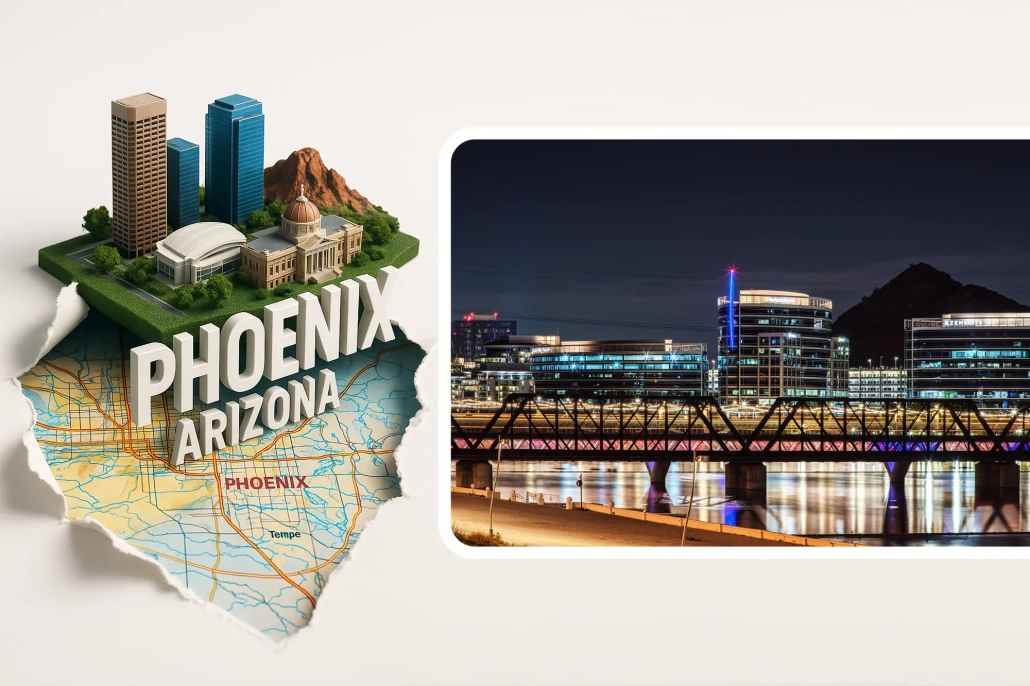Phoenix Bound: Why the Valley of the Sun Attracted America’s Movers in 2025
by: Rick Rome
The Allure of Endless Sunshine and Outdoor Paradise
Phoenix gets more than 300 sunny days per year, with winters bringing mild daytime highs in the 60s and 70s (°F). No blizzards. No ice storms. For many, escaping long, gray winters is a draw.
Outdoor life is baked into the region: hiking Camelback Mountain at dawn, biking along the Arizona Canal in the evening, or teeing off year-round at courses in Sun City or around Scottsdale. Retirees are drawn by quieter lifestyles and amenities, adventure seekers swap snow for desert trails, and natural wonders like the Grand Canyon are just a drive away.
Jobs Galore in a Booming Economy
Phoenix’s economy has been expanding across multiple sectors. Major semiconductor fabs from Intel and TSMC continue to grow. Companies like GoDaddy maintain strong tech presences. Healthcare, mining, and manufacturing also anchor the area: Mayo Clinic and Freeport-McMoRan are examples of large employers headquartered or operating in the region.
Unemployment has tended to hover at or slightly below the U.S. average in recent months, reflecting a relatively healthy labor market by many measures.
In a notable example of corporate relocation, Dutch Bros announced that it is moving a significant portion of its corporate/support staff to Tempe—about 200+ jobs—as part of its HQ expansion in Arizona.
Affordability That Actually Adds Up
Compared to many coastal metros, Phoenix provides big city features without quite as heavy a price tag. Median home sale prices in 2025 have generally ranged between $400,000 and $485,000, depending on neighborhood and month—much lower than many coastal California metros where median prices commonly exceed $800,000.
Arizona’s tax structure sweetens the deal: a flat income tax rate of 2.5%, no state estate tax, and overall living costs that are near the national average, and substantially below those in many parts of California.
Household income needed to maintain a middle-class standard of living is lower here than in many expensive metros, freeing up more budget for recreation, culture, or savings.
Culture, Sports, and a Vibe That’s Hard to Beat
Phoenix offers a rich mix of arts, culture, and recreation. You’ll find the Heard Museum presenting Native American art, Arizona Opera performances, and live music at venues like the Talking Stick Amphitheatre. Sports fans have MLB’s Diamondbacks, NBA’s Suns, and NFL’s Cardinals. And with Arizona State University’s Tempe campus nearby, there’s a young, energetic edge to parts of the city.
Neighborhoods like Downtown Phoenix buzz with restaurants, bars, galleries, and newer “James-Beard-nominated” chefs; Old Town Scottsdale provides luxury shopping, nightlife, and a hint of western charm. In many ways, the city feels like it’s reinventing itself daily, with efforts underway for heat-mitigation, water conservation, and more sustainable urban design.
The Movers: Top States Pouring into the Valley
Where are people coming from?
Data from U-Haul’s 2025 Midyear Migration Trends, state migration reports, and census estimates show:
Rank Origin State Primary Pull Factors
1 California – High housing costs, high taxes, congestion
2 Washington – Rainy weather, high cost of living
3 Texas – Job opportunities; some moving for calmer climate
4 Colorado – Overcrowding, higher altitude, cost
5 Oregon – Cost of living, weather, desire for sunnier climate
In addition to western states, many Midwesterners—especially from Illinois, Michigan, Ohio—are increasingly relocating to Arizona for warmer winters and lower living costs.
In 2023, Arizona recorded a net domestic in-migration of about 62,533 people, with the Phoenix area attracting the lion’s share. Early indicators suggest that migration into 2024 and into 2025 are continuing (though data is still being finalized).
Challenges & Looking Forward
Phoenix isn’t perfect. Summers remain blistering (triple-digit highs), creating high energy demands and heat-related risks. Water sustainability is a pressing concern—limited supply, pressure on the Colorado River system, and long-term demand growth mean planning and conservation are essential.
Nevertheless, innovation is in motion: efforts in urban design, like implementing reflective or “cool” pavements, advanced recycling, smart landscaping, and water reuse, are underway in many parts of the Valley.





